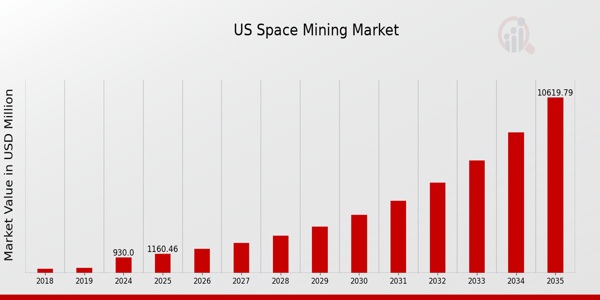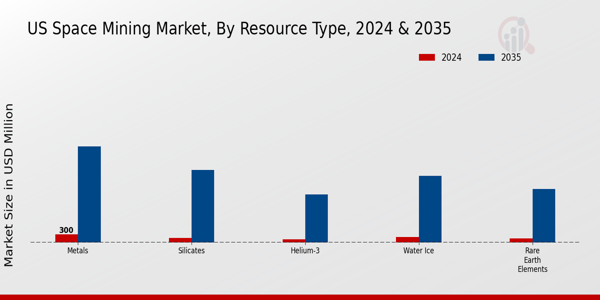US Space Mining Market Overview
The US Space Mining Market Size was estimated at 730.8 (USD Million) in 2023. The US Space Mining Market Industry is expected to grow from 930(USD Million) in 2024 to 10,620 (USD Million) by 2035. The US Space Mining Market CAGR (growth rate) is expected to be around 24.781% during the forecast period (2025 - 2035).

Source: Primary Research, Secondary Research, Market Research Future Database and Analyst Review
Key US Space Mining Market Trends Highlighted
The US space mining market is witnessing significant momentum driven by advancements in technology and increasing interest from both private companies and governmental agencies. Key market drivers include the escalating demand for rare minerals and resources that are essential for technological and manufacturing needs on Earth. The US government has shown commitment towards space exploration, with initiatives such as the Artemis program aimed at establishing a sustainable human presence on the Moon and potentially facilitating lunar resource extraction.
This governmental backing enhances the feasibility of commercial space mining operations, attracting investments and partnerships.In recent times, the focus on sustainability has opened opportunities for the US space mining industry to explore extraterrestrial resources as a means to reduce reliance on terrestrial mining, which often raises environmental concerns. The availability of abundant resources such as water ice on the Moon or asteroids presents an attractive prospect for not just fuel and drinking water for space missions, but also for the production of oxygen and hydrogen.
These trends highlight a shift towards a more sustainable future with a multi-faceted approach that encompasses scientific research, resource utilization, and environmental preservation. The collaboration between private sector innovators and government programs is fostering an environment ripe for breakthroughs in capabilities related to spacecraft design, processing technologies, and in-situ resource utilization.Moreover, as the industry evolves, regulatory frameworks are being developed to ensure responsible practices in space. This evolving landscape in the US space mining market demonstrates a growing recognition of the importance of space resources, positioning the US at the forefront of this emerging field.
The interplay of these trends and drivers indicates that the US is poised for a significant role in the global space mining future.
US Space Mining Market Drivers
Increasing Government Investment in Space Exploration
The US Space Mining Market Industry is poised for significant growth due to increased government funding for space exploration initiatives. The National Aeronautics and Space Administration (NASA) has outlined ambitious plans to enhance capabilities for asteroid mining and deep-space missions, with substantial budget allocations amounting to billions of dollars annually. In 2022, NASA's budget reached approximately 24 billion USD, demonstrating a commitment to long-term space exploration goals.Government support not only provides essential funding but also stimulates private sector investment, encouraging companies such as SpaceX and Blue Origin to develop technologies that could facilitate mining operations in space.
Moreover, collaboration with organizations like the United States Geological Survey (USGS) helps identify valuable resources in space, enhancing the prospective investment landscape of the US Space Mining Market Industry.
Technological Advancements in Space Mining Equipment
Innovative advancements in technology are significantly influencing the US Space Mining Market Industry. New developments in robotic systems, autonomous spacecraft, and ore processing technologies are being actively researched and developed by key players like Lockheed Martin and Northrop Grumman. The adoption of advanced robotics for harvesting materials from asteroids can dramatically reduce operational costs and improve efficiency.
The availability of funding from governmental bodies like NASA supports Research and Development initiatives in these areas, resulting in more efficient mining technologies.For instance, a collaborative initiative between NASA and private companies aims to create mining robots capable of operating in harsh extraterrestrial environments, which, in turn, is anticipated to boost industry growth and expand market prospects.
Growing Demand for Rare Earth Elements
The rising demand for rare earth elements, essential for various high-tech and renewable energy applications, is driving the US Space Mining Market Industry. The US relies heavily on imports for these materials, creating an urgent need for domestic sources. Current evaluations indicate that asteroids are rich in precious metals and rare elements, which has attracted interest from both private companies and government agencies.
According to the United States Geological Survey (USGS), the US imported over 80% of its rare earth metals in recent years.As the demand for clean energy components like batteries increases, the ability to mine these elements from space will be crucial for reducing dependence on foreign resources and ensuring national security, thus creating ample market opportunities in the US Space Mining Market.
US Space Mining Market Segment Insights
Space Mining Market Resource Type Insights
The US Space Mining Market is experiencing significant growth, driven by various resource types essential for advancing space exploration and sustainable activities beyond Earth. This segment encompasses several critical resources, including Water Ice, Metals, Rare Earth Elements, Helium-3, and Silicates, each offering unique advantages and opportunities for mining initiatives in space.
Water Ice is increasingly recognized for its potential role as a vital resource for supporting human life in space, serving as a source of drinking water and facilitating the production of hydrogen fuel.The ability to harvest Water Ice from celestial bodies can drastically lower the costs associated with long-term space missions, promoting self-sufficiency for lunar bases and Mars exploration efforts. Metals, which include iron, nickel, and cobalt, are essential for construction and manufacturing in space.
The abundance of these resources on asteroids could significantly reduce the need to launch these materials from Earth, leading to an efficient cycle of space infrastructure development. Rare Earth Elements hold immense significance due to their crucial role in modern technologies such as electronics and renewable energy systems.The discovery and extraction of these elements in space could stabilize supply chains and lessen reliance on terrestrial sources that are often subject to geopolitical tensions.
Helium-3 is particularly noteworthy, as it has the potential to provide a clean and efficient energy source for future fusion reactors, offering a promising avenue for sustainable energy production on Earth and beyond. Lastly, Silicates, forming the majority of the solid matter found on planetary bodies, represent an essential resource for in-situ resource utilization, allowing for the creation of building materials necessary for establishing habitats on the Moon or Mars.Each of these resource types collectively informs US Space Mining Market strategies, driving research and investment interest as the industry aims to operationalize space mining principles.
This segment’s continued development is supported by government partnerships and commercial initiatives, as stimulating technological advancements and addressing regulatory frameworks are critical for unlocking these resources that could redefine humanity's presence in the cosmos. As the market evolves, competition among private and public entities will likely foster innovation and efficiency, setting the stage for a new era of exploration and utilization of off-Earth resources.

Source: Primary Research, Secondary Research, Market Research Future Database and Analyst Review
Space Mining Market Technology Insights
The Technology segment of the US Space Mining Market plays a crucial role in advancing capabilities for extracting resources from celestial bodies. With the increasing interest in asteroid mining, various approaches such as Robotic Mining, Autonomous Mining, and Human-Piloted Missions are emerging. Robotic Mining is significant due to its ability to operate in harsh environments, minimizing human risk while increasing efficiency and precision in resource extraction.
Autonomous Mining leverages advanced algorithms and AI, enabling machines to make real-time decisions without human intervention, thus optimizing operations.This segment showcases technological innovation that is not only essential for cost-effective mining but also for ensuring safety and sustainability in the cosmos. Human-Piloted Missions provide the necessary oversight and adaptability required in unpredictable environments, enabling humans to work alongside autonomous systems. The combination of these technologies represents a diversified approach that enhances the overall effectiveness of space mining operations, positioning the US at the forefront of this emerging industry.
Overall, the Technology segment is pivotal in driving the future of US Space Mining Market, reflecting a high potential for growth and various operational efficiencies.As demand for extraterrestrial resources rises, understanding these segments becomes increasingly important for stakeholders in the market.
Space Mining Market Application Insights
The Application segment of the US Space Mining Market plays a vital role in advancing the industry, as it encompasses crucial areas such as In-Situ Resource Utilization, Material Extraction, and Fuel Production. In-Situ Resource Utilization is significant because it focuses on conserving resources while reducing the cost of transporting materials from Earth. This approach could enhance sustainability in space missions.
Similarly, Material Extraction is essential for acquiring valuable resources, including rare metals and minerals that are increasingly scarce on Earth, driving innovation in methods of extraction and processing in space environments.Fuel Production, meanwhile, is critical for supporting long-term space exploration initiatives, as it enables the use of local resources to generate necessary fuels for propulsion, ultimately enhancing mission feasibility and reducing reliance on Earth-based supplies.
The US government's interest in space infrastructure development and the increasing involvement of private entities in space activities are fostering growth in these areas, making the Application segment a key driver of progress in the US Space Mining Market. As advancements continue, these applications will likely evolve, paving the way for a more sustainable and economically viable presence in outer space.
Space Mining Market End Use Insights
The End Use segment of the US Space Mining Market encompasses various critical applications including Space Exploration, Commercial Space Operations, and Scientific Research. Space Exploration serves as a foundational driver for the market, with government investments and private sector partnerships enabling missions aimed at the Moon, Mars, and beyond; this pursuit enhances global standing and technological progress while fostering international collaboration.
Commercial Space Operations are gaining traction as private enterprises increasingly engage in activities like satellite launching and asteroid mining, reflecting a shift toward monetizing outer space resources.The growth of companies in this space indicates a robust interest in establishing profitable operations, critical for the long-term viability of space resource utilization. Scientific Research remains paramount, contributing to our understanding of celestial bodies and supporting advancements in technology and materials science that can be derived from extraterrestrial resources.
Overall, these applications underline the significant potential for the US Space Mining Market as it evolves, driven by innovation and the need for sustainable resource management in the coming decades.
US Space Mining Market Key Players and Competitive Insights
The US Space Mining Market is an emerging frontier that combines elements of aerospace technology, resource extraction, and commercialization of outer space. With advancements in technology and increasing interest from both public and private sectors, this market is witnessing progressively intensified competition. As various companies seek to capitalize on untapped resources found on celestial bodies, competitive insights become crucial in navigating this complex landscape. Factors such as technological capabilities, partnerships, investment capacities, and regulatory compliance are pivotal for firms aiming to establish their presence within this nascent field.
The race to secure valuable resources, including rare minerals and metals, is not only economically motivated but is also seen as a strategic imperative for future space exploration and sustainability efforts on Earth.TransAstra has carved a niche in the US Space Mining Market through its novel approach to resource extraction on asteroids and other celestial bodies. The company's strength lies in its innovative technologies, including the development of spacecraft designed specifically for in-orbit processing of materials.
As TransAstra works on a range of projects aimed at demonstrating the viability of space mining, its unique position within the market is further enhanced by a focus on developing partnerships with various governmental and commercial entities. These collaborations amplify its research and operational capabilities, establishing a strong foothold in the competitive landscape.
TransAstra's commitment to advancing sustainable space exploration assures its relevance as stakeholders aim to leverage resources found beyond Earth, thereby contributing to the long-term viability of the space economy.Boeing has also made significant strides in the US Space Mining Market, leveraging its extensive experience in aerospace technology and innovation. Known for its work on NASA's Artemis program and involvement in various satellite systems, Boeing is strategically positioned to engage in the burgeoning space mining sector. The company’s key products and services in this domain include satellite development, propulsion systems, and advanced robotics that could facilitate mining operations in space.
Boeing's established reputation and robust supply chains present a competitive advantage as it looks to engage in mergers and acquisitions to strengthen its market presence further. With an emphasis on innovation and sustainability, Boeing's ventures aim not only to capitalize on resources such as water and minerals found in space but also to support broader goals of creating a sustainable off-planet economy. The blend of technological prowess, industry partnerships, and strategic growth initiatives reinforces Boeing's competitive stance within the US Space Mining Market.
Key Companies in the US Space Mining Market Include
- Asteroid Mining Corporation
- Sierra Nevada Corporation
US Space Mining Market Industry Developments
The US Space Mining Market has seen significant developments recently, particularly with companies like NASA and Lockheed Martin intensifying their efforts in asteroid mining initiatives. TransAstra has been actively promoting its technology aimed at extracting resources like water and metals from celestial bodies, aligning with growing government support for space resource utilization. Additionally, Moon Express is making strides toward lunar resource extraction, while Planetary Resources and Deep Space Industries continue to advance their projects aimed at harvesting asteroids for valuable materials. These developments reflect an increasing valuation within the market, driven by anticipated demand for resources as space exploration expands.
In September 2023, Rocket Lab and iSpace announced a partnership focusing on lunar missions that is expected to enhance resource extraction capabilities. Moreover, mergers and acquisitions have also shaped the landscape, with Blue Origin acquiring small-scale mining technology companies to bolster its lunar ambitions in April 2023. The US Space Mining Market is expected to grow significantly, spurred by federal funding and collaboration between private aerospace firms and governmental agencies.
US Space Mining Market Segmentation Insights
Space Mining Market Resource Type Outlook
Space Mining Market Technology Outlook
Space Mining Market Application Outlook
- In-Situ Resource Utilization
Space Mining Market End Use Outlook
- Commercial Space Operations
Report Scope:
| Report Attribute/Metric Source: |
Details |
| MARKET SIZE 2018 |
730.8(USD Million) |
| MARKET SIZE 2024 |
930.0(USD Million) |
| MARKET SIZE 2035 |
10620.0(USD Million) |
| COMPOUND ANNUAL GROWTH RATE (CAGR) |
24.781% (2025 - 2035) |
| REPORT COVERAGE |
Revenue Forecast, Competitive Landscape, Growth Factors, and Trends |
| BASE YEAR |
2024 |
| MARKET FORECAST PERIOD |
2025 - 2035 |
| HISTORICAL DATA |
2019 - 2024 |
| MARKET FORECAST UNITS |
USD Million |
| KEY COMPANIES PROFILED |
TransAstra, Boeing, Lockheed Martin, Moon Express, iSpace, NASA, Asteroid Mining Corporation, Sierra Nevada Corporation, Planetary Resources, Deep Space Industries, Luxembourg Space Agency, OffWorld, Blue Origin, Rocket Lab, SpaceX |
| SEGMENTS COVERED |
Resource Type, Technology, Application, End Use |
| KEY MARKET OPPORTUNITIES |
Asteroid resource extraction technologies, Lunar mining for rare minerals, In-space manufacturing and construction, Partnerships with government agencies, Investment in sustainable space practices |
| KEY MARKET DYNAMICS |
technological advancements, regulatory challenges, investment opportunities, resource scarcity, international collaboration |
| COUNTRIES COVERED |
US |
Frequently Asked Questions (FAQ):
The US Space Mining Market is expected to be valued at 10,620.0 million USD by 2035.
In 2024, the US Space Mining Market is expected to be valued at 930.0 million USD.
The US Space Mining Market is anticipated to have a CAGR of 24.781% during the forecast period from 2025 to 2035.
Water Ice is projected to dominate the US Space Mining Market with a value of 2,500.0 million USD by 2035.
The market value for Metals in the US Space Mining Market is expected to be 300.0 million USD in 2024.
Key players in the US Space Mining Market include TransAstra, Boeing, Lockheed Martin, and NASA.
Helium-3 is expected to reach a market size of 1,800.0 million USD in the US Space Mining Market by 2035.
Innovation in space exploration and the increasing demand for resources are significant growth drivers for the US Space Mining Market.
Emerging trends such as advancements in technology and increased investments are positively influencing the US Space Mining Market.
The anticipated market value for Rare Earth Elements in the US Space Mining Market is 2,000.0 million USD by 2035.















